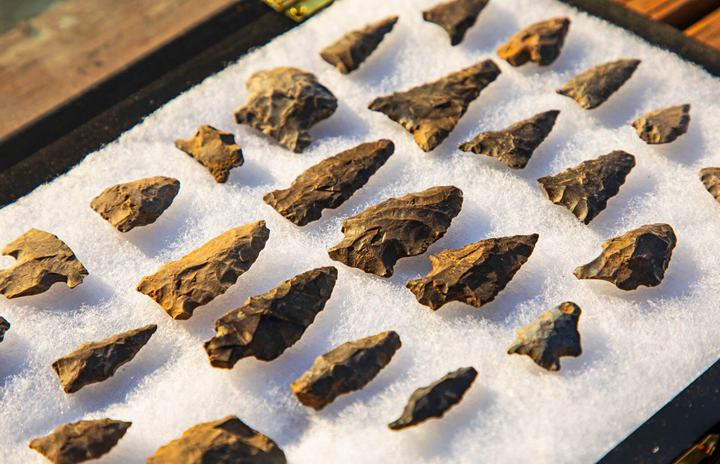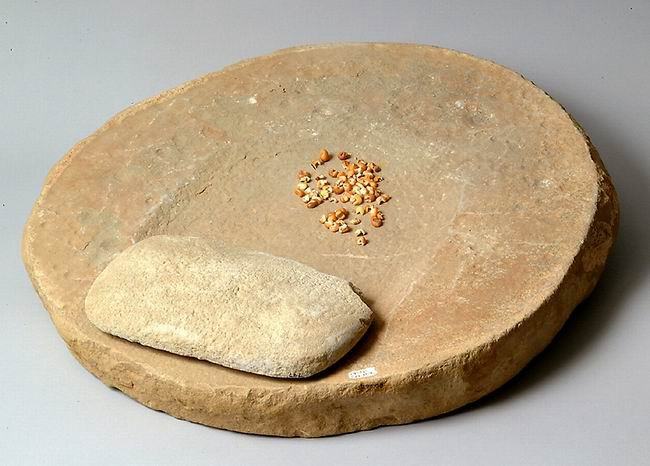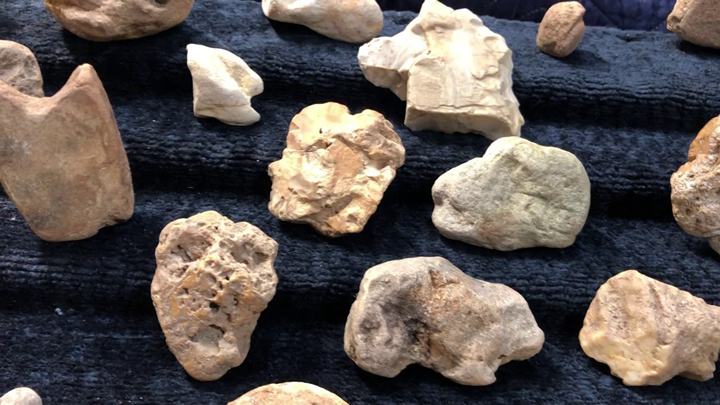There is a long history of collecting Native American stone tools and weapons. For many people, these pieces are more than just objects; they are a connection to the past. Some collectors focus on a specific tribe or region, while others collect anything that catches their eye. No matter what their approach, collectors often have a deep respect for the cultures that created these pieces.
Native American stone tools and weapons were used for everything from hunting and gathering to warfare. They are often incredibly well-crafted, and they can provide insight into the lives of the people who used them. For example, arrowheads can tell us about the types of animals that were hunted, while spears can reveal information about how battles were fought. Collectors take great care in handling and preserving these artifacts, as they represent an important part of our history. In this blog post, we will take a comprehensive look at stone tools and weapons used by Native Americans!
Table of Contents
The Importance of Stone Tools and Weapons in Native American Culture
For Native Americans, stone tools and weapons were more than just functional objects – they were an integral part of their culture and beliefs. For centuries, these tools and weapons were used for everything from hunting and gathering food to making war on other tribes. With such a wide range of uses, it is not surprising that stone tools and weapons were some of the most prized possessions of Native American tribes.
Not only were they used for everyday tasks such as hunting and cooking, but they also had spiritual and ceremonial significance. Stone was thought to be a sacred material, and so artifacts made from it were often used in rituals and ceremonies. They were also believed to have protective powers, and so were often worn as talismans or used to decorate dwellings. In some cultures, the stone was seen as a link between the physical and spiritual worlds, and so it was used in shamanic practices such as vision quests and healing rituals.
Game stones were also popular among the Native Americans. Some of the earliest examples of Native American game stones date back to around 3,000 BCE. These small, polished rocks were typically made from materials like granite or limestone, and they were used in a variety of games. One popular game was called “chunkey,” in which players would roll a round stone along the ground and then throw spears at it.
The Different Types of Stone Tools and Weapons
Depending on the tribe, Native Americans used a variety of stone tools and weapons. Native American stone tools and weapons can be divided into two broad categories: chipped and ground.
Chipped Stone Tools and Weapons

Chipped stone tools are created by striking a rock another rock to break off small pieces, which can then be sharpened to create a cutting edge. These tools are versatile and can be used for everything from hunting and gathering to woodworking.
Over the years, many different types of chipped stone tools have been found, ranging from simple flake tools to more complex projectile points. One of the most famous examples is the Folsom point, a type of spear point that was used by Native Americans during the Paleo-Indian period.
Some of the most fascinating examples of Native American chipped stone tools come from the Great Plains region of the United States. Here, a type of stone known as obsidian was regularly used to create a wide variety of sharp implements. One type of obsidian tool that was particularly popular was the arrowhead. Arrowheads were usually less than two inches long and were attached to shafts in order to be used as projectile weapons. However, they were also sometimes used as knives or scrapers.
In addition to being made from obsidian, arrowheads were also sometimes created from flint or chert. These materials were all easily worked and allowed for the creation of very sharp edges.
Other types of chipped stone tools that were popular among Native Americans included axes, hammers, and adzes. These larger implements were often used for woodworking or carving projects. Like arrowheads, they were usually made from obsidian, flint, or chert. The blades of these tools were incredibly sharp and could be used for a variety of tasks. In addition to being practical tools, many of these larger chipped stone implements also served as ceremonial objects. They might have been given as gifts or used in rituals and ceremonies.
Ground Stone Tools and Weapons

The type of stone tool known as a ground stone tool is one in which the stone has been shaped by grinding, rather than by striking with another object. Ground stone tools were used by various Native American cultures prior to the arrival of Europeans in North America.
These tools were typically used for tasks such as shaping wood or bone, grinding plant material into powder, or sharpening other stone tools. In many cases, the stones used to make ground stone tools were carefully selected for their hardness and durability. As a result, these tools were often highly prized by their owners and were passed down from generation to generation.
The most common type of ground stone tool was the ax. Axes were used for a variety of tasks, including felling trees and shaping wood. They were also used as weapons. Another common type of ground stone tool was the hammerstone. Hammerstones were used to shape other stones and to crush plant material. They were also used as hammers and anvils during the manufacturing of other tools.
A Metate is a Native American grinding stone used for a variety of tasks. While they are most often associated with food preparation, they can also be used for tasks such as shaping wood and sharpening tools. Grinding stones are typically made from large pieces of stone or granite, and they can vary significantly in size. The metate itself is a flat surface on which other objects can be ground or pulverized.
Metates typically have a concave depression in the center of the grinding surface, which is used to hold food or other materials in place while they are being ground. The surrounding areas of the metate are usually scoured clean so that only the desired material is ground up. In some cases, grooves or patterns may be carved into the grinding surface in order to create decorative effects.
Effigy Stones

Native American effigy stones are some of the most fascinating and mysterious artifacts from the pre-contact period. These stones, which are found primarily in the eastern woodlands of North America, take the form of animals, humans, and other creatures. While their exact purpose is unknown, they are thought to have been used for ceremonial or spiritual purposes.
Effigy stones are often found in burial mounds, suggesting that they may have been used as part of funerary rituals.
However, they have also been found in other contexts, such as near rivers or along paths. Regardless of their original purpose, rare Native American effigy stones provide a valuable glimpse into the worldview of the Native Americans who created them.
Native American Stone Tools and Weapons Identification Guide
Native American stone tools and weapons can be difficult to identify because there are no clear-cut categories. Here are some things that can help you identify rare Native American rocks and stones:
Analyze the Shape
By studying the shape and other characteristics of these artifacts, archaeologists can often determine if they are man-made or natural geological formations. For example, looking at the edge of a stone tool, if it is smooth, then it was probably created by human hands. On the other hand, if the edge is jagged, it is more likely that the object is a naturally occurring rock. Native American artifacts are often decorated with intricate designs. These designs can be either carved into the stone or added as an embellishment, so look for these as well.
Many stone tools and weapons were designed to be ergonomic, fitting comfortably in the hand of the user. As a result, if a tool feels comfortable to hold, it is likely that it was used by Native Americans. Under a microscope, you may be able to see tiny flakes of stone that have been chipped off over time. This is evidence that the tool was used for its intended purpose. You may also look for crafting marks, such as notches or grooves. By examining the shape and surface of the stone, you can usually get a good idea of its function and history.
Compare to Similar Artifacts
When trying to identify if a stone tool is Native American, it is important to compare it to other similar artifacts. By looking at the different materials used, markings, and sizes of the tools, you can start to get a better idea of which type of tool it is and where it might be from. For example, Native American tools are typically made out of materials like obsidian or flint, while other cultures may use materials like bone or wood.
In addition, Native American tools are often marked with specific designs or symbols, whereas other cultures have different marking styles. Finally, Native American tools tend to be smaller and more delicate than those from other cultures. All of these factors can help you to narrow down the origin of a stone tool and whether or not it is Native American.
Identification Native American Effigy Stones
Due to their great age, effigy stones are often found in a fragmentary state. However, there are a few key features that can help to identify them. First, look for carvings that depict animals or humans in an elongated or distorted way or carvings that show figures in profile or from above. Pay attention to the overall style of the carving as effigy stones from different regions will often have unique stylistic elements.
Effigy stones are often highly polished, which likely indicates that they were once used as sacred objects. Finally, many effigy stones feature small drilled holes, which were used to hold offerings such as feathers or beads. By familiarizing yourself with these characteristics, you will be able to spot Native American Effigy Stones wherever you find them.
Resources
There are many resources that can serve as your Native American stone tool identification guide. Here are some of our recommendations:
- Indian Axes and Related Stone Artifacts (Indian Axes & Related Stone Artifacts: Identification & Values)by Lar Hothem
- Arrowhead Adventures The Ultimate Guide to Indian Artifact Huntingby William Bauer
- Prehistoric Chipped Stone Tools of South Carolinaby Tommy Charles and Christopher R Moore
- Arrowheads and Stone Artifacts, Third Edition: A Practical Guide for the Amateur Archaeologist (The Pruett Series)by C.G. Yeager and George C. Frison
- Warman’s North American Indian Artifacts: Identification and Price Guideby Rusell Lewis
- The Native American Tool Boxby Lloyd E. Schroder
- A Field Guide to Stone Artifacts of Texas Indians (Gulf Publishing Field Guide Series.)by Ellen Sue Turner
Additionally, you can get your rare Native American rocks and stones appraised at specialized institutions, for example:
- Native American Art Appraisals, Inc.
- Indian Artifact Grading Authority
- Elmore Art Appraisals
- McAllister Fossum
Where to Find Native American Stone Tools and Weapons for Sale
While Native American stone tools and weapons are no longer in widespread use, they can still be found for sale in a number of places.
Online
Online auction sites such as eBay or 1stDibs are worth checking, as there is often a wide selection of items available. More specialist websites like Native American Vault or Wandering Bull also have Native American stone tools and weapons for sale. When buying rare Native American stones and rocks online be sure to do your research to make sure you’re dealing with a reputable seller.
Powwows
A powwow is a Native American gathering that includes singing, dancing, and feasting. It is a time for people to come together to celebrate their culture and heritage. Powwows typically take place during the summer months, and they are a great way to meet Native American artisans and learn about their work. If you’re lucky, you can find authentic Native American goods, including stone tools and weapons. You can check the calendar of upcoming powwows on this website.
Antique Stores and Pawn Shops
If you’re interested in purchasing Native American stone tools or weapons, your best bet is to check out antique shops and pawn stores. You might be able to find what you’re looking for online, but it’s often more expensive and you won’t be able to inspect the item in person before making a purchase.
At an antique shop or pawn store, you’ll be able to examine the item closely to make sure it’s in good condition and that it’s the real thing. You might also be able to haggle over the price, which is always a bonus. Just be sure to do your research beforehand so you know what you’re looking for and what a fair price would be.
FAQ
What did Native Americans use stone axes for?
Native Americans used stone axes for a variety of purposes, including hunting, woodworking, and warfare. The most common type of ax was the hand ax, which could be used for a variety of tasks such as chopping down trees or shaping wood. Axes were also used as weapons, and the sharpened edge could be used to deliver a deadly blow in close combat.
How much is a stone Indian Tomahawk worth?
A stone Indian Tomahawk can be worth anywhere from $6,000 to $8,000. The value of the Tomahawk depends on a few factors, such as its age, condition, and rarity. The most valuable Tomahawks are those that are very old and in excellent condition.
Is it legal to own Native American artifacts?
If an artifact is found on private land, the owner of that land is usually considered to be the legal owner of the artifact. However, it is illegal to take archaeological materials from federal or Indian lands without a permit.
How do you know where to dig for arrowheads?
Some of the best places to look for arrowheads are along the water line. This is because water is a powerful force that can quickly erode the land, revealing any buried artifacts in the process.
Conclusion
Native American stone tools and weapons were some of the most important tools in their toolkit. From sharpening knives and spears to building shelter and fashioning jewelry, these tools were used for a variety of tasks. While many of the materials used to make these tools have since been lost to time, archaeologists have been able to piece together a general idea of how they were made. This guide provides an overview of the different types of stone tools and weapons used by Native Americans. It also describes how these tools were used and provides information on where they can be found today.






![Vintage Schwinn Bikes: [Types, Identification, and Values]](https://www.txantiquemall.com/wp-content/uploads/2022/05/5.-Schwinn-1967-Ramshorn-Fastback-Stingray-Sky-Blue-vtg-600x450.jpg)
